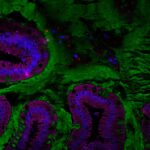Link to Pubmed [PMID] – 27570813
Cell Mol Gastroenterol Hepatol 2016 May; 2(3): 274-280
This study showed that the absence of CCR7 or mesenteric lymph nodes/gut-associated lymphoid tissue did not appreciably impact total intestinal Foxp3+ regulatory T cell representation in the steady-state. However, mesenteric lymph nodes/GALT are required for normal peripherally induced Foxp3+ regulatory T cell differentiation in the small intestine, but not in the large intestine.Foxp3+ regulatory T cells (Tregs) in the intestine promote immune tolerance to enteric antigens. Previous studies have shown that C-C chemokine receptor 7 (CCR7)-dependent migration of intestinal dendritic cells to the mesenteric lymph nodes (mLN) is involved in peripheral Foxp3+ Treg accumulation in the intestine and the establishment of oral tolerance. However, the relative contribution of this CCR7+ dendritic cell-mLN-Treg axis to the total intestinal Foxp3+ Treg pool during the steady-state remains unclear. In this study, the contribution of CCR7, as well as the mLN and gut-associated lymphoid tissue (GALT), to the intestinal Foxp3+ Treg compartment in the small intestine (SI) and large intestine (LI) was assessed.Intestinal Foxp3+ Tregs were quantitated in Ccr7-/- mice and in mice devoid of secondary lymphoid organs-including mLN and GALT-owing to a deficiency in lymphotoxin (LT) signaling. Specific analyses of Foxp3+Helios+ thymically derived (t)Tregs and Foxp3+Helios- peripherally derived (p) Tregs in the SI and LI, as well as the role for them LN in supporting Foxp3+ pTreg development using the B6.Cg-Tg(TcraTcrb) 425Cbn/J/ovalbumin (OVA) feeding system, were performed.Foxp3+ Tregs were enriched in the intestine relative to the mLN, independent of CCR7. In the absence of the mLN and GALT, normal frequency and numbers of Foxp3+ Tregs were observed in LTα-deficient (Lta-/-) mice. However, Foxp3+Helios- pTregs were decreased in the SI of Lta-/- mice, corresponding with defective Foxp3+ pTreg expansion to OVA. In the LI, however, the proportion of Foxp3+Helios- pTregs and Foxp3+ pTreg induction to OVA was comparable between Lta-/- and Lta+/+ mice, which coincided with preferential expression of Treg-inducing/immunoregulatory cytokines.The overall size of the intestinal Foxp3+Treg pool is not impacted significantly by CCR7, mLN, or GALT during the steady-state. However, mLN/GALT appear to contribute to the Foxp3+ pTreg compartment in the SI, particularly in response to soluble oral antigen. These findings highlight important differences in the regulation of intestinal Tregs between the SI and LI, and suggest that enteric antigens may use mLN/GALT to induce Foxp3+ pTreg in the SI, while directly promoting Foxp3+ pTregs in the LI.


